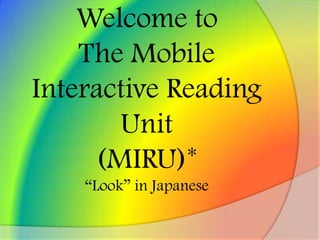
Using Your Textbook
- 1. Welcome to The Mobile Interactive Reading Unit(MIRU)*“Look” in Japanese
- 2. College Textbook Reading Why don’t students read? Is it because there’re no quizzes on the reading? Is it because their professor never talks about the reading assignment? Maybe the assignments are too long.
- 3. MIRU for You (MIRU) will demonstrate two very successful uses of Reading Strategies available for FREE at the Reading Center on campus in Bldg. C 107.
- 4. Effective College Textbook Reading Think about a purpose! Think about your assignment! Think about how to make efficient use of your reading time!
- 5. First Reading Strategy: Pivotal words are words that guide you This Reading Strategy is using flashcards with pivotal words written on them. This helps to guide your mind along the pathway.
- 6. Examples of Pivotal Words War is a way of shattering to pieces, or pouring into the stratosphere, or sinking in the depths of the sea, materials which might otherwise be used to make the masses too comfortable, and hence, in the long run, too intelligent. George Orwell, 1984 It was a bright cold day in April, and the clocks were striking thirteen. George Orwell
- 7. Examples of Pivotal Words On November 9, 1984, Ceaser E. Chavez delivered Common Wealth. “The Republicans control the governor's office and the White House. They say there is a conservative trend in the nation. Yet we are filled with hope and encouragement. We have looked into the future and the future is ours!”
- 8. Flashcards Flashcards are an important technique for remembering, especially for those students who have difficulty retaining information. It’s also good to enhance your comprehension.
- 9. Second Reading Strategy:Using the SQ3R Method SQ3R is a study-reading technique designed to help students effectively read their assignments, textbooks and tests.
- 10. Here’s how you do it: Practice PracticePractice Survey a book Survey a chapter
- 11. Survey Read the summaries at the end of the chapters and books. Read topical sentence and subtopical headings and sentences by critically skimming through the text.
- 12. Here’s how you do it: Practice PracticePractice Question 1. Turn each of the main points found in the introduction, headings, topic sentences, or summary into a question. 2. Use these questions to guide your reading.
- 13. Here’s how you do it: Practice PracticePractice Read Read the section you have surveyed using your questions as a guide.
- 14. Here’s how you do it: Practice PracticePractice Recite Restate the main points and supporting details in your own words while you read.
- 15. Here’s how you do it: Practice PracticePractice Review At the end of your study period, review the material you have covered using your notes, outline, or marked portions of the text to see how much you can remember.
- 16. SQ3R Survey. Question. Read. Recite. Review. Final Tips & Reminders: Note the differences in textbooks from discipline to discipline. Schedule reading time. Preview assignment. Read with a purpose. Write and talk to improve comprehension. Use your voice. Read in several short periods of time.
- 18. Pick out important points
- 19. Remember more
- 20. Quiz questions will become familiar Students will often see immediate improvement in their comprehension and memory of reading assignments.
- 21. FREE FREEFREEFREE The Reading Center will help you with your reading needs. Come see us in Building C Room 107 OR give us a call at (213) 763- 3753. Thank you for your time.
Hinweis der Redaktion
- Some students report that they do not keep up with their reading assignments, while others read but do not retain the information.
- Whyshould students read?Supplement class lecture and notes.Build on previous knowledge.Read to learn, write to learn, talk to learn.To follow what’s happening in class.
- Pivotal words help clarify and guide a reader to different ideas and parts of sentences. They help you by connecting from one phrase to the next and direct your attention. There are many groups of pivotal words so once you master them you will be able to you use them correctly and becoming a better reader.
- Too = “It does what I have just said, but it does this too.”Other Than = “Sometimes there is a choice; other times there isn’t.”And= “Here’s more of the same coming up. It’s just as important as what we have already said.”
- Yet = Contrast and change words “ So far I’ve given you only one side of the story, now let’s take a look at the other side.”
- SQ3R is one of many strategies that help students:Identify the most important points quickly.Distinguish between main ideas and details.Situate information into memory.Comprehend information quickly.Review for exams efficiently.During this lecture think about how you can adapt this reading strategy to the reading assignments from various disciplines.
- S= Survey the textTitlePreface, introduction, purpose, thesis, approachTable of contents, topics, subtopics, organizationChapter highlights, summaries, study questions, appendicesSample a paragraph from your reading assignment to determine how much time you will need for the entire reading assignment. Consider the following:Your purpose for reading the material.Your level of interest in the material.Your concentration span.The reading level and rate at which facts are presented.
- WRITE these notes on paper, in sequence; then look over the notes to get an overall idea or picture.
- What information do you hope to gain from reading the material?What do you already know about this topic?What do you think the author might say?
- Several periods of study spaced over time will help you retain information more effectively than one long period of study just prior to an exam.
- Pass out SQ3R SheetHave students make notations on each sectionTesting recall
- S= Survey the AssignmentNow survey the assignmentsTitleIntroductionSub – headingsTopic sentencesIllustrations, charts, graphs, etc.Chapter summary, discussion questions